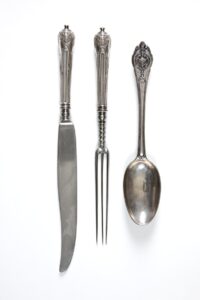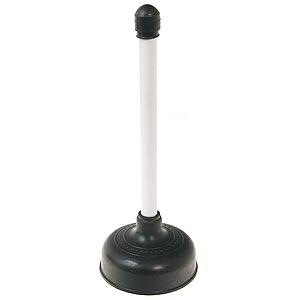Pro TIps
How To Free Up A Clogged Kitchen Sink Disposal
If you use your garbage disposal with any kind of regularity, you know that clogs are inevitable. Learning to dislodge clogs yourself can save a lot of time and money. These methods will help you clear away multiple types of clogs such as the type that occurs inside the unit (superficial clogs) and the type that occurs inside the pipe leading away from the unit.
Superficial Clogs

Superficial clogs happen all the time. These are the types of clogs that occur when something undesirable enters through the garbage disposal opening and ends up inside the unit. Most commonly, these types of clogs are caused by kitchen utensils like spoons, forks and knives.
Sometimes superficial clogs stop the unit from working because it becomes too jammed. Other times, the unit will work with whatever is inside of it clanging around. If you’ve ever broken a glass into your sink, this type of clog can also be caused by shards of broken glass that have become wedged in the mechanical parts of the disposal. Here’s how you can fix this type of problem:
- Unplug your garbage disposal
- Shine a flashlight into the garbage disposal opening and search the disposal until you identify the problem. Most often, this type of clog will be caused by something large and easy to spot
- Reach down inside the disposal with tweezers or tongs. You may use your bare hands to do this, but do so gingerly. Consider wearing plastic gloves. The bare metal blades at the bottom of your disposal may not be too sharp, but they can do damage even when not turned on
- Turn the blades manually if you can’t identify the source of the problem. There could be something hidden behind or underneath one of the blades
- Plug the disposal back in then turn on and off the disposal quickly. If the clog still exists, you’ll hear it inside the unit, clanging around
Pipe Clogs
The food inside the garbage disposal is filtered into a pipe that carries food away. Sometimes, this pipe becomes clogged. This pipe is usually connected to the other side of your sink and may be connected to other pipes in your kitchen. If your garbage disposal becomes backed up, you may experience a problem when both sides of your sink refuse to drain. There are a few ways you can fix this problem.
Plunging

Plunging is an inexpensive way to dislodge many standard clogs. Use a good-quality plunger for this type of project: don’t buy the cheapest plunger available. The better the plunger, the more likely it is to solve your problem.
- Plug the other side of the sink
- Place the plunger on top of the garbage disposal opening
- Toggle the plunger up and down until the clog in the garbage disposal is dislodged and the water level goes down
Chemical Clog Treatments
Chemical clog removers are available for sale in most pharmacies, home improvement stores, big box retailers and grocery stores. Most chemical clog treatments are acceptable to use in garbage disposal units, and may even be used to increase slow drain speeds in the event of a partial clog.
- Read the instructions on the product label
- Pour chemical clog treatment into the opening of your garbage disposal unit. Use only as much chemical clog treatment as specified by the manufacturer
- Wait for the amount of time specified in the manufacturer’s instructions
- Turn on the water and the garbage disposal unit. Step away from the garbage disposal opening to prevent the product from splashing into your eyes or on your skin
- Repeat as necessary
Calling In Professional Help
Sometimes clogs inside pipes can’t be gotten rid of with a plunger or chemical treatments. Some handy homeowners are comfortable taking apart their pipes to fix clogs personally, but for many homeowners, this is the time when a plumber must be called in. For jobs like this, you’ll want to have a plumber you trust.
